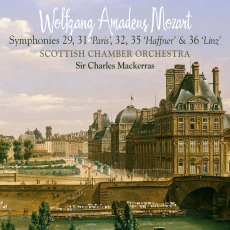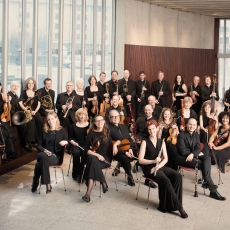Mozart Symphonies 2 - SCO & Sir Charles Mackerras - MusicWeb International
When I reviewed this team in a concert last January I said that few things can bring a smile to the face like an evening spent in the company of Sir Charles Mackerras. Happily the same is true of this CD, coming on the heels of the orchestra's fabulously successful and wonderfully played recording of Mozart's last symphonies. Many of us hoped that Linn would follow that earlier issue with more from Mozart's symphonic canon, and after listening to this CD I find that the hunger for more has only increased, so rich is the experience on offer here.
Mackerras has spent a lifetime getting inside Mozart's music and for much of that lifetime his discoveries have been made with his beloved Scottish Chamber Orchestra. This is a team that knows each other and the composer inside out and, while Mackerras brings his lifetime of experience to enrich this music, this CD is what it is because of the warmth, trust and affection between conductor and band. That's apparent first of all in the beautifully warm string playing that characterises Symphony No. 29. Its gentle contours are shaped with love and affection but it always surges forward purposefully, not least in the bustling first movement: listen out for the cheeky horns in the coda, a distinctive Mackerras touch. There is plenty of room to breathe in the second movement, however, taken here at a more upbeat pace but still sounding lovely because of its characteristic string playing. This gives way to rhythmic bounce and jollity in the menuet before an exhilarating finale. In all of these symphonies, as in the previous recording, Mackerras observes every available repeat.
I don't think I've ever heard the Paris symphony sound quite so overtly majestic as it does here. The opening is surely the grandest, most self-confident beginning in Mozart's symphonic output, not surprising when he was writing it to gain the favour of the Paris audience. The natural brass and timpani bring the extrovert character to the fore and, while the second subject is well contrasted, the sense of scale is maintained right to the end. The Paris audience was unhappy with the symphony's original slow movement so Mozart wrote an alternative, the one we are more used to hearing today. Both are included here, and the original has rather more forward momentum than the one we are used to, but both have their appeal. The perpetuum mobile of the finale is every bit as exciting as the rush of the first movement. The under-rated No. 32 is given in its version with trumpets and timpani, and excitement is the key note here too, though there is plenty of room to linger in the central Andante. Timothy Jones' excellent booklet notes tell us a lot about this symphony's unusual form, as well as providing excellent contextual background and analysis for all the works.
The Haffner's first movement bristles with energy while the slow movement is full of understated poise. The menuet restrains the bluster and the finale is whole-scale fun writ large, especially in some of the string figurations of the coda.
The Linz, my favourite Mozart symphony, is full of restrained grandeur, though the slow introduction sounds a little thin. The pace and energy of the Allegro sets the pulse racing and the period-style playing gives an edge to the music which makes it all the more immediate. The slow movement sways with magisterial grace and makes the most of the troubling plunges into the minor key. The menuet is lithe and flexible and the finale is tremendously exciting, especially in the frenetic repeated quavers of the coda.
All told this is top-notch stuff from a winning team. Linn's recorded sound is exemplary and this issue deserves to earn as many awards as its predecessor.


